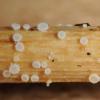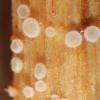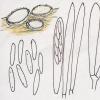
04-05-2014 17:27
 Chris Yeates
Chris Yeates
Bonjour tousrecently collected on dead stems of th

30-04-2014 22:03
Till LohmeyerSorry, with an endless series of messages I have

02-05-2014 16:12
This small group, hiding under a Scutellinia, look

23-07-2013 23:37
Esquivel-Rios EduardoEste Xylariaceae encontrado en madera muerta tiene

01-05-2014 01:17
 Rubén Martínez-Gil
Rubén Martínez-Gil
Hola a todos. Subo unas fotos de una Peziza que e
Lachnum
Gilbert MOYNE,
04-05-2014 18:35
Un Lachnum qui me pose problème ...
Habitat : sur tige morte de Polygonatum verticilliatum, Amancey, Grand Bois, en compagnie de Trichopezizella nidulus.
Apothécies sessiles, ne dépassant pas 1 mm de diamètre, cupuliformes. Hympénium blanc à vaguement couleur paille très clair, Surface externe blanche.
Asques sans crochets, J+, contenant 8 spores biséries, 35-45 x 3-5 µm.
Paraphyses lancéolées dépassant les asques d'environ 15 µm, (x 4-5 µm), sans gouttes.
Spores étroitement elliptiques, 7-9 x 1,5-2 µm, sans gouttes ou parfois quelques granulations.
Poils assez obtus au sommet, souvent un peu capités, granuleux, pas de cristaux, 70-80 x 4-5 µm
J'ai cherdhé dans la clé de Zotto,( - - - ) mais rien trouvé de bien convaincant.
Je pensais que l'habitat particulier m'aiderait mais rien non plus de ce côté là.
Quelques photos de Jean-Marc Moingeon.
Merci à vous
Gilbert
Daniel Ghyselinck,
04-05-2014 18:44
Re : Lachnum
Salut Gilbert,
J'ai des récoltes de Lachnum eburneum sur Polygonatum, la micro ressemble à ça il me semble.
Amitiés,
Daniel
J'ai des récoltes de Lachnum eburneum sur Polygonatum, la micro ressemble à ça il me semble.
Amitiés,
Daniel
Gilbert MOYNE,
04-05-2014 20:14
Re : Lachnum
Merci Daniel.
Je vais refaire quelques préparations pour essayer de trouver des cristaux.
Gilbert
Je vais refaire quelques préparations pour essayer de trouver des cristaux.
Gilbert
Gilbert MOYNE,
05-05-2014 08:54
Re : Lachnum
J'ai repris le Lachnum et il est vrai que sur certains poils,on trouve des cristaux granuleux assez importants donc + - - et ça convient parfaitement pour Lachnum eburneum. Merci encore Daniel.
Gilbert
Gilbert


